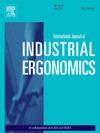评估一个新的最大桌高方程:整合教育家具设计中的生物力学安全性和人体测量学契合度
IF 3
2区 工程技术
Q2 ENGINEERING, INDUSTRIAL
International Journal of Industrial Ergonomics
Pub Date : 2025-05-01
DOI:10.1016/j.ergon.2025.103756
引用次数: 0
摘要
本研究评估了一个新的定义教育环境中最大书桌高度的方程,并通过生物力学分析将其与传统的基于Chaffin和anderson的方程进行了比较。基于30°肩外展和35°屈曲的新方程,在一项涉及34名参与者的准实验研究中根据既定标准进行了测试。利用运动捕捉和表面肌电图,我们分析了在两种办公桌高度下执行六项标准化任务时的肩部运动学和肌肉活动。结果显示,在两种情况下,肩部运动学安全参数没有显著差异,而肌电图数据显示,两种情况下的肌肉活动模式在10% MVC以下是一致的。跨任务的绩效指标显示,办公桌高度之间没有显著差异。偏好分析显示,不同条件之间总体上没有显著差异,尽管有66%的女性更喜欢建议的身高。两种情况下的不适程度是相似的。在现有数据库上对新方程进行理论检验(n: 2261名学生;N: 2946名工人)显示出改善的人体测量契合度,将学生的匹配率从63%提高到94%,并将工人的高匹配率从46.7%降低到7.1%。研究结果证实,新的方程保持生物力学安全,同时显着提高人体测量契合度。这种生物力学和人体测量标准之间的一致性代表了教育家具设计的进步,特别是与需要前臂支撑的当代教育任务相关。本文章由计算机程序翻译,如有差异,请以英文原文为准。
Evaluating a novel maximum desk height equation: Integrating biomechanical safety and anthropometric fit in educational furniture design
This study evaluates a new equation for defining maximum desk height in educational settings, comparing it with the traditional Chaffin and Anderson-based equation through biomechanical analysis. The new equation, based on 30° shoulder abduction and 35° flexion, was tested against established criteria in a quasi-experimental study involving 34 participants. Using motion capture and surface EMG, we analyzed shoulder kinematics and muscle activity during six standardized tasks performed at two desk heights. Results showed no significant differences in shoulder kinematics safety parameters between setups, while EMG data revealed consistent muscle activity patterns below 10 % MVC for both conditions. Performance metrics across tasks showed no significant differences between desk heights. Preference analysis indicated no overall significant difference between conditions, although gender-specific patterns emerged with 66 % of women preferring the proposed height. Discomfort levels were comparable between conditions. Theoretical testing of the new equation on existing databases (n: 2261 students; n: 2946 workers) demonstrated improved anthropometric fit, increasing match rates from 63 % to 94 % in students and reducing high mismatch cases from 46.7 % to 7.1 % in workers. The findings validate that the new equation maintains biomechanical safety while significantly improving anthropometric fit. This alignment between biomechanical and anthropometric criteria represents an advancement in educational furniture design, particularly relevant for contemporary educational tasks requiring forearm support.
求助全文
通过发布文献求助,成功后即可免费获取论文全文。
去求助
来源期刊
CiteScore
6.40
自引率
12.90%
发文量
110
审稿时长
56 days
期刊介绍:
The journal publishes original contributions that add to our understanding of the role of humans in today systems and the interactions thereof with various system components. The journal typically covers the following areas: industrial and occupational ergonomics, design of systems, tools and equipment, human performance measurement and modeling, human productivity, humans in technologically complex systems, and safety. The focus of the articles includes basic theoretical advances, applications, case studies, new methodologies and procedures; and empirical studies.

 求助内容:
求助内容: 应助结果提醒方式:
应助结果提醒方式:


